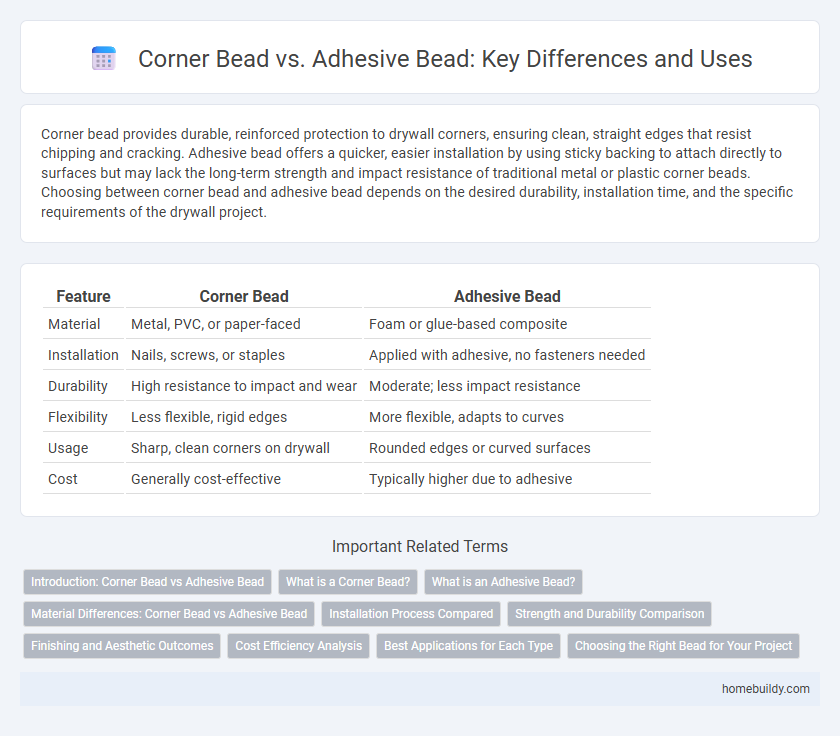Corner bead provides durable, reinforced protection to drywall corners, ensuring clean, straight edges that resist chipping and cracking. Adhesive bead offers a quicker, easier installation by using sticky backing to attach directly to surfaces but may lack the long-term strength and impact resistance of traditional metal or plastic corner beads. Choosing between corner bead and adhesive bead depends on the desired durability, installation time, and the specific requirements of the drywall project.
Table of Comparison
| Feature | Corner Bead | Adhesive Bead |
|---|---|---|
| Material | Metal, PVC, or paper-faced | Foam or glue-based composite |
| Installation | Nails, screws, or staples | Applied with adhesive, no fasteners needed |
| Durability | High resistance to impact and wear | Moderate; less impact resistance |
| Flexibility | Less flexible, rigid edges | More flexible, adapts to curves |
| Usage | Sharp, clean corners on drywall | Rounded edges or curved surfaces |
| Cost | Generally cost-effective | Typically higher due to adhesive |
Introduction: Corner Bead vs Adhesive Bead
Corner bead is a traditional drywall reinforcement material, typically made from metal or plastic, designed to protect and strengthen wall corners from damage. Adhesive bead, by contrast, is a newer innovation that uses a strong adhesive backing to simplify installation without the need for nails or screws, offering a cleaner finish. Both options enhance corner durability, but adhesive bead reduces labor time and potential wall damage during application.
What is a Corner Bead?
A corner bead is a metal or plastic strip used to reinforce and protect the external corners of drywall installations, ensuring clean, straight edges and increased durability. Unlike adhesive beads, which rely primarily on glue to adhere to surfaces, corner beads are typically nailed, screwed, or embedded in drywall compound for a more secure and long-lasting finish. Corner beads help prevent damage and cracking on corners, contributing to a professional and polished drywall appearance.
What is an Adhesive Bead?
An adhesive bead is a strip used in drywall installation to reinforce corners without the need for traditional metal corner beads. It typically consists of a flexible, mesh or vinyl material coated with a strong adhesive that bonds directly to drywall surfaces, ensuring a smooth and crack-resistant edge. This method provides an easier and faster application while maintaining durability in high-impact areas.
Material Differences: Corner Bead vs Adhesive Bead
Corner beads are typically made from galvanized steel, aluminum, or PVC, offering durability and impact resistance for protecting drywall corners. Adhesive beads, in contrast, are generally composed of flexible plastic or foam materials with adhesive backing, designed for easy application and slight flexibility on surfaces. The rigid structure of corner beads provides stronger reinforcement, while adhesive beads prioritize ease of installation and minor surface protection.
Installation Process Compared
Corner bead installation involves securing metal or plastic strips with nails, screws, or staples along drywall corners for durability and sharp edges. Adhesive bead installation relies on applying a strong glue or adhesive tape, offering faster application with less tool requirement but potentially less long-term stability. The mechanical fastening in corner beads generally ensures better alignment and resistance to impact compared to adhesive bonding methods.
Strength and Durability Comparison
Corner beads made from galvanized steel or PVC offer superior strength and durability compared to adhesive beads, which rely heavily on the adhesive bond and can degrade over time. Steel corner beads resist impact, corrosion, and cracking, making them ideal for high-traffic or exterior applications where long-lasting protection is critical. Adhesive beads are easier to install but tend to be less resilient under stress, often requiring more frequent repairs or replacements.
Finishing and Aesthetic Outcomes
Corner bead provides precise edge protection and a clean, sharp finish, enhancing the overall durability of drywall corners in construction projects. Adhesive bead offers a smoother surface with less visible seams, resulting in a more refined and aesthetically pleasing appearance for interior spaces. Choosing between corner bead and adhesive bead depends on the desired balance between structural reinforcement and seamless visual appeal.
Cost Efficiency Analysis
Corner bead offers a more cost-efficient solution compared to adhesive bead due to its lower material and installation expenses, reducing overall project budgets significantly. The durability and ease of application of corner bead minimize labor costs and potential rework, leading to long-term savings. Adhesive bead often requires specialized adhesives and longer curing times, increasing both upfront and maintenance costs.
Best Applications for Each Type
Corner beads excel in reinforcing drywall corners, providing durability and crisp edges, making them ideal for high-traffic areas and professional finishes. Adhesive beads offer flexibility and ease of installation, best suited for quick repairs, DIY projects, and surfaces where nailing is impractical. Selecting the right type depends on application requirements, surface conditions, and desired finish quality for optimal results.
Choosing the Right Bead for Your Project
Corner beads provide durable protection for drywall corners, ensuring crisp edges and resistance to impact, while adhesive beads offer quicker installation and flexibility for uneven surfaces. When choosing the right bead for your project, consider factors such as the level of traffic, desired finish quality, and installation time. For high-traffic areas, metal or vinyl corner beads offer superior durability, whereas adhesive beads are ideal for small repairs or curved corners needing a smooth finish.
corner bead vs adhesive bead Infographic

 homebuildy.com
homebuildy.com